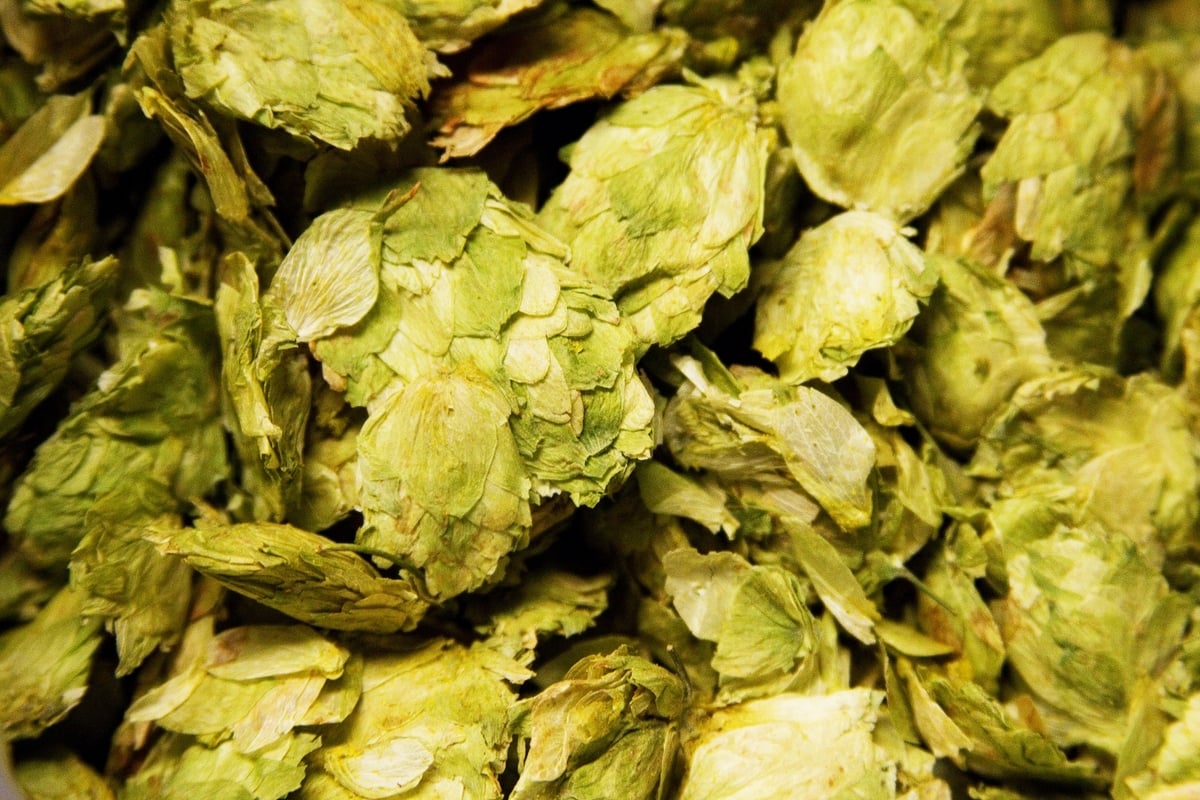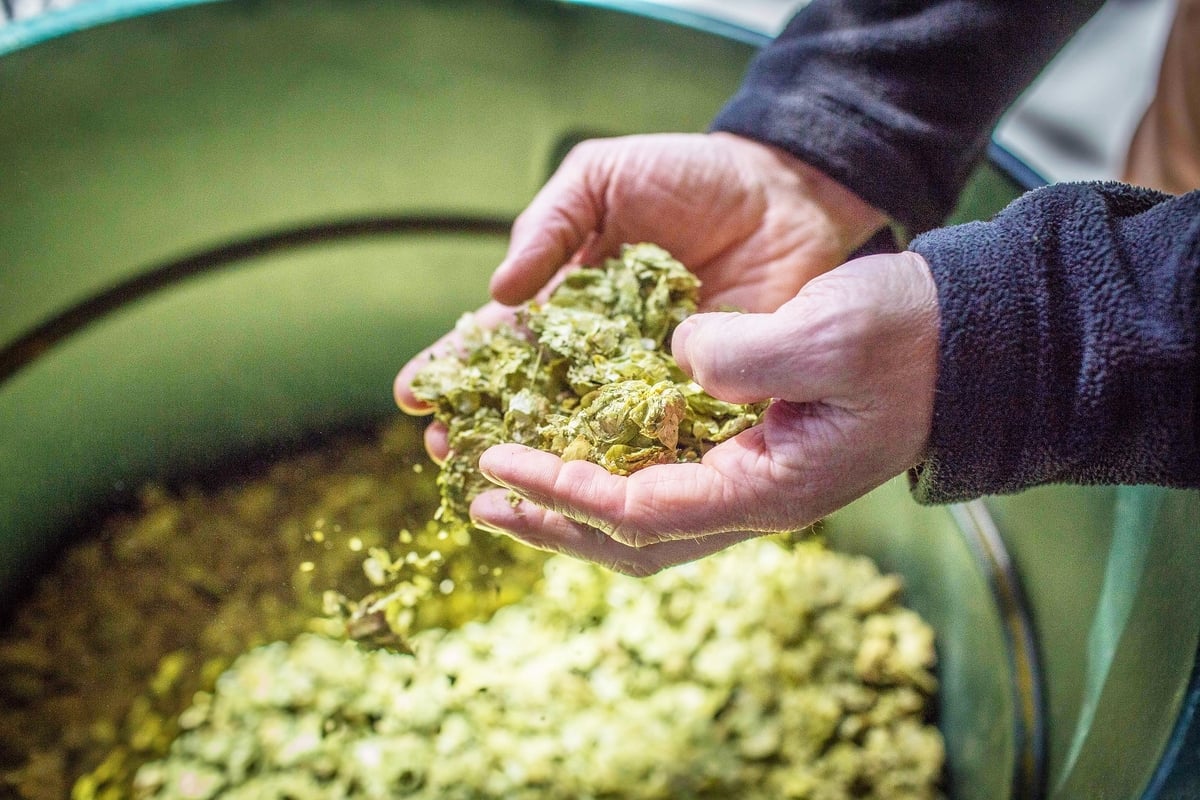Start 14-Day Trial Subscription
*No credit card required

The 9 Most Influential Hops of All Time
Hops form a vital role in today's diverse brewing industry, and hop varieties possess distinct personalities that range from floral German noble hops, to woody British strains, to pungent early American varietals, all the way to the citrusy, tropical fruit-like hybrids being developed for today's modern IPAs. This story spotlights nine of the most influential hops of all time in brewing history.
During the turbulent Middle Ages, brewers across Europe began substituting hop flower cones for the bitter, pungent and sometimes toxic herbs and spices typically used in the production of ales. Hop flowers proved effective in warding off the microbial demons involved in souring and spoiling beer, and spicy, aromatic hop bitterness provided an ideal counterbalance to beer's sweet maltiness. Even though England's infamous King Henry VIII referred to hops as "a wicked and pernicious weed," most of England and Europe soon became enamored with hoppy brews.
Hops flowers sprout from tall, perennial, female vines of the humulus lupulus plant - a close family member of cannabis. Hop flowers sometimes possess similar aroma and flavor characteristics to cannabis, while lacking any THC. Hops provide the seasoning and spice in beer, and when hops are boiled in the brewing process for an hour or so, they produce a delightful bitterness. Spicy, floral, fruity aromatics and flavors emerge when hops are added near the end of the boil, and dry hops dosed directly into fermenters or kegs impart an even deeper bouquet.
Cascade
In the 1970s, Sierra Nevada Brewing Co. founder Ken Grossman dreamed of making a British-style pale ale using American hops. On a road trip to Yakima, Washington, Grossman talked a hop grower out of a few pounds of whole cone hop samples that included the under-appreciated Cascade variety. After a multitude of test batches, the pioneering, Cascade-focused Sierra Nevada Pale Ale was released in March of 1981… and the American hop palate would never be the same. Cascade offers succulent notes of flowers, citrus, pine and grapefruit that were scarce in European hop varieties.
"There wouldn't be craft beer as we know it without the Cascade hop,” said Mitch Steele, formerly with Stone Brewing Company and now owner/brewer of New Realm Brewing. “Before craft beer, citrusy American hops were snubbed by most of the world's brewers. The advent of American Pale Ale and American IPA with Cascade hops has changed the world's beer game forever."
Centennial
Centennial hops hit the American brewery scene around 1990 and come from crosses of Fuggle, East Kent Golding, Brewers Gold and Bavarian varietals. As beer palates adjusted to the new-fangled hop character imparted by Cascade, American craft beer enthusiasts soon demanded more intensity. More is always better, right? Known as "Super Cascade," Centennial offers bold citrus notes, backed by impressive pine/floral character and crisp bitterness. Due to its disease-resistance, hardiness and role in the production of a wide range of beer styles, Centennial has now been embraced by craft brewers around the world.

Centennial hops offer bold citrus notes, backed by impressive pine/floral character and crisp bitterness.
Photo Courtesy Flickr/mygalsalphotos
Citra
When American craft brewers asked for new hop strains that could provide stronger citrus, tropical and exotic fruit profiles, Citra was the answer. Usage of the Citra hop varietal began around 1990 with a cross between Hallertau Mittelfruh, Tettnang, Brewer's Gold, East Kent Golding and an unnamed American wild hop. Beers showcasing Citra boast complex hop personalities that appeal to modern craft beer brewers and drinkers, and Citra currently ranks as the most planted and popular craft hop by acreage. "Citra was one of the original tropical hops with big notes of mango, passion fruit and lime,” noted John Roberts, hop enthusiast and brewer at Atlanta's Max Lager's brewpub. “It was a revelation in flavor, aroma and intensity."
Fuggle
Throughout the latter part of the Industrial Revolution in the 1800s, pubs across England sold pints of cask-conditioned Porter hopped with Fuggle – an easygoing aroma hop with low bittering acids. In the mid-1900s, almost 80 percent of English-grown hops were Fuggle. The subtle aromatics and earthy flavors reminiscent of flowers and wood tannins made for a perfect marriage for malty Porters, Milds and English Bitters. Although Fuggle has begun to fall out of favor in modern U.K. craft brewing, the hop still holds a revered place in the hearts of many classic British brewers. John Keeling, master brewer for London's respected Fuller's Brewery, shared, "To me, Fuggle is the hop of Porter. At the heart of Fuggle's character is the understated balance given by the textured, subtle bitterness – the perfect counterpoint to Porter's roasted malt flavors."
Golding
Grown in the southeastern Kent region of the U.K., Golding hops began to overtake Fuggle in the 20th century. Offering a more complex floral, spicy aroma and flavor, Golding became the hop of choice for English Ordinary, Best and Strong Bitter in pubs across the country. East Kent Golding hops are considered by most classic U.K. brewers as the premium Golding varietal, and the hops are even shipped across the channel for use in several Belgian ales. John Keeling notes that his Fuller's ESB uses a large percentage of Golding. He explains, "When we started shipping Fuller's ESB to America, it was the lovely orange ESB flavor, which is a combination of Golding's fruitiness and our own yeast esters, that launched a thousand ESB imitations in breweries and brewpubs across the States."

When American craft brewers asked for new hop strains that could provide stronger citrus, tropical and exotic fruit profiles, Citra was the answer, such as in this Allagash Brewing collaboration with Sierra Nevada.
Photo Courtesy Flickr/Allagash Brewing
Hallertau
"Noble hops" are typically mild in bitterness and offer beautiful, floral, spicy, honeysuckle aromas and flavors. Noble hops include European cultivars such as Hallertau, Tettnanger, Spalt and Saaz. German Hallertau probably ranks as the premier noble hop, and many American soldiers stationed in Europe during the last century fell in love with German lagers that showcased Hallertau hops. Grab a stein of fresh German pilsner in Munich, and an intense, exquisite Hallertau character will shine through. Jim Koch started The Boston Beer Company by featuring Samuel Adams Boston Lager made with a load of elegant Hallertau Mittelfruh hops that impart aromatic, spicy resins, providing a lovely harmony to the toasty, biscuity German malts.
Mosaic
Today's craft beer revolution centers around creativity and complexity, so it only follows that there would be a demand for an innovative hop with a huge depth of complexity. With Mosaic's layered notes of berry, stone fruit, mango, rose petal, herbs, kiwi, pine and even bubblegum, this hop is truly a "mosaic" of aromas and flavors that push the boundaries of what hop growers can accomplish. In only a few years of existence, Mosaic acreage in the Pacific Northwest has expanded tremendously, with demand exploding from craft brewers worldwide.
Nelson Sauvin
Originating in the Nelson region of New Zealand, the Nelson Sauvin hop arose from a breeding program started in 1985 by the Plant and Food Research Institute of New Zealand. The hop proved to be disease-resistant and prefect for the Kiwi climate and soil, and the first thing growers and brewers noted was its unique winey character, often compared to Sauvignon Blanc. Nelson Sauvin's set of hop oils include an unusual collection of compounds that also put forward essences of honeydew, elderberries, passion fruit, grapefruit, apricot, white pepper, lychee and green grapes. Along with Mosaic, Nelson ranks as one of the industry's most multifaceted, intriguing hops.
Saaz
After attractive glassware was introduced in Europe in the 1800s, a clear, sparkling, golden lager was invented in the Czech town of Plzen. After all, a beautiful glass deserved a beautiful beer. Bohemian Pilsner showcased golden pilsner malt from Moravia balanced by Saaz hop aroma, flavor and bitterness. Traveling through the hop country of the Czech Republic in early summer often provides views of Czech college students making some extra cash by caressing young Saaz hop vines, training them on twine leading 18 feet up hop poles. With nuances of flowers, spice, herbs and mild bitterness, Saaz is considered by many as the most elegant and refined noble hop varietal. It now plays a fundamental role in most European-style lagers brewed around the globe.

The hop fields of St. Bernardus, which feature varietals such as Fuggles and Goldings.
Photo Courtesy Flickr/Bernt Rostad
For the Love of Hops
Aside from the importance of hops in providing aroma, flavor, bitterness, anti-bacterial qualities and head retention in beer, hops simply make beer fun. Hoppy American-style IPAs are adored and rank as the most popular craft beer in America. Who knows what beer's hoppy future might hold? New varietals are released every year, and researchers are working on innovative CO2-extracted hop resin oils, cryogenically separated hop powders and yeast strains that actually produce hop aroma and flavor during fermentation. This “wicked and pernicious weed” has come a long way!



